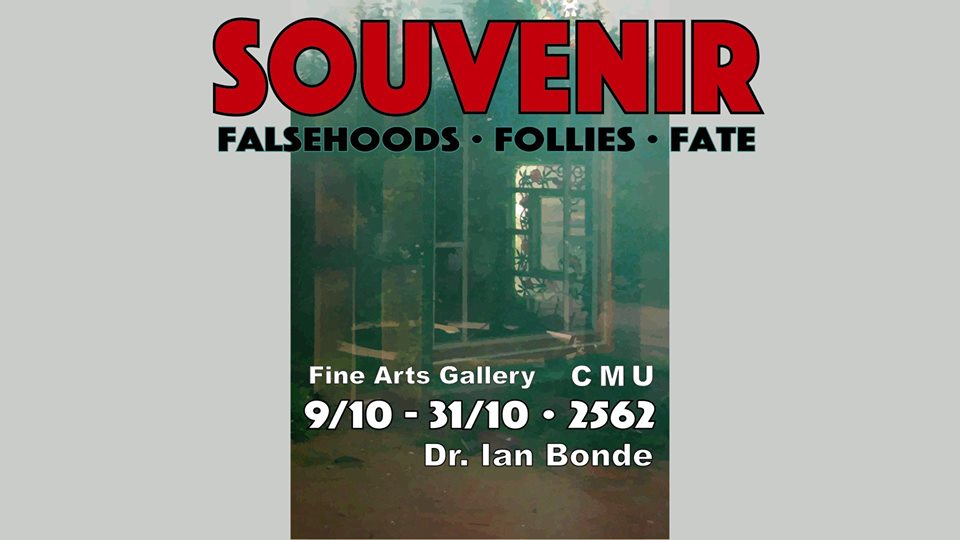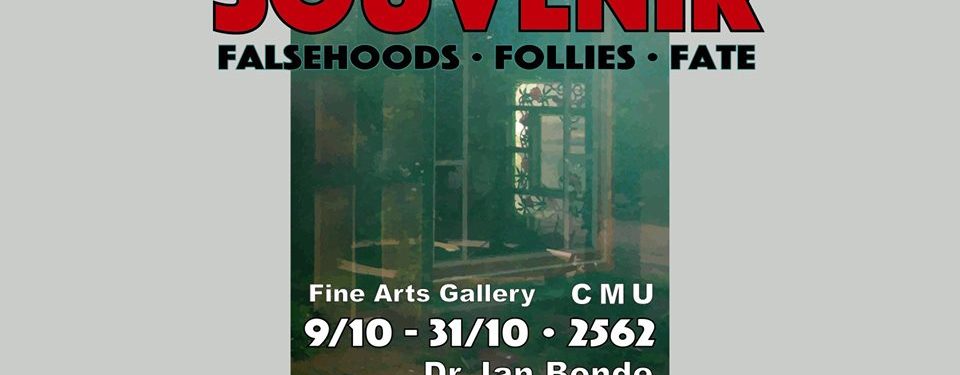
Wednesday 9th October 2019
A Chance Encounter – whilst visiting Chiang Mai a few years ago, the artist found himself riding around the old city on a trusty rental moped. It began to rain and he looked for a place to shelter. Stopping in front of what appeared to be an unusual abandoned building with ornate decoration, he discovered an access point and cautiously entered. Nobody seemed to be present and he was able to explore the interior. It became apparent that as well as its dilapidated and damaged state (with obvious evidence of vandalism and neglect) this ornate pseudo Baroque fantasy mansion was also clearly unfinished. Intrigued, he proceeded to investigate, capturing images of the foreboding atmosphere and the architectural details; beautiful stained glass windows, plaster motifs on ceilings, plaster garland reliefs on window surrounds and bare concrete stair cases and passageways. Curiously, he also discovered playing cards and animal bones. Finally, amongst the large exterior columns, he found many sculpted figures overlooking the city from the upstairs balcony.
Citylife has actually done a story on this spooky house which you can read here. But it appears that artist Dr. Ian Bonde took his curiosity much further.
Hubris in the House of Success – upon investigating the history of the site, he found the story of Thai property mogul, ‘Tycoon Jack’ who built ‘Janghuarinnakorn House’ (a.k.a. the White Lion Mansion) as a private residence for himself and his family and the building behind (House of Success) as sales offices for his elite business executives. Sadly, with the collapse of the Thai property market in the late 1990s, it is said that the eccentric millionaire went insane and murdered his family in their home, butchering them into pieces.
According to local legend, Tycoon Jack’s enterprise was doomed from the outset. It is said that the site of the property, on the North West corner of the city moat was a potent mix of bad feng shui and Thai superstition, and would bring bad luck. Furthermore, the ornate pastiche of European architecture was considered to be a vulgar display of wealth by ordinary local people, especially within the walls of the old city and particularly when competing with the height of the surrounding temples.
Superstitions and memorials are important elements in the culture of Thai people, as evidenced by the prevalence of the ubiquitous spirit houses and shrines devoted to loved ones. The ‘ghosts’ of ‘Tycoon Jack’s’ family were said to inhabit his grand architectural folly and both buildings remained abandoned for more than 20 years. There is a certain morbid fascination for foreigners with ‘ghost buildings’ in Thailand. Many can be found on the internet with tales of the supernatural, misfortune and misery.
The artist’s journey of discovery through ‘Tycoon Jack’s’ extravagant buildings resonated strongly, echoing previous experiences of personally visiting many historical palaces, stately homes and abandoned buildings whilst living in Europe.
This exhibition is a sculptural response to the artist’s encounter with the House of Success and White Lion Mansion and subsequent knowledge and understanding of the story of the site, history of the building and the fate that befell the occupants. It is also an extension of his ongoing research into the culture/ nature paradox, entropy and stasis. He is interested in how we human beings try to control nature in order to define and separate ourselves from it and how ultimately, these efforts are futile. People attempt to create everlasting monuments to extend our fleeting presence in this planet. However, time and the forces of nature eventually overcome these structures to reveal the true hubris of the enterprise.
The artist’s sculptural works are based on platonic forms and regular shapes – cube, oval, circle, sphere etc. They are literally follies as constructions echoing Baroque architecture and landscape architectural designs, including the archetypal squaring of the circle and Fibonacci progressions. He has also incorporated elements of birth, growth, death, order and chaos. His ‘Photo Essay’ of snapshots taken on the day are intended as a reference to tell the story.
Venue: The Fine Arts Faculty Gallery
